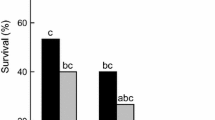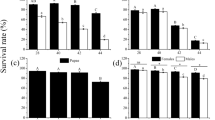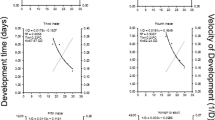Abstract
The flea beetle, Agasicles hygrophila, was introduced to control the alligator weed, Alternanthera philoxeroides, in southern China and redistributed for over 20 years. The beetle has succeeded in establishing local field populations. Temperature, especially extreme low temperature in winter, is hypothesized to be a key factor determining the distribution of A. hygrophila. We studied the adult reproduction and leaf consumption, egg hatching rate, larval and pupal survival and development of A. hygrophila in response to low non-freezing temperatures. Female and male adults of A. hygrophila survived at 4°C for 11.4 and 14.2 days, respectively, and adult longevity increased with increasing temperature from 4 to 12°C. Adult longevity was significantly longer at 12°C than at 25°C, and the fecundity at 12°C was approximately 10% of that at 25°C. When A. hygrophila eggs, first instar larvae and pupae were kept at 4–12°C for 1, 4, 7 or 10 days, respectively, and then transferred to 25°C, over one third of eggs hatched after cold treatment at 4°C for 7 days, with an average egg development duration of 3.6 days excluding the cold treatment period. Egg hatching rate increased as temperature during the cold treatment increased and the cold treatment duration reduced. Eggs pretreated at 12°C and those kept constantly at 25°C did not differ in their hatching rates. The first instar larvae of A. hygrophila could not survive 12°C or lower, and exposure to these low temperatures resulted in 100% mortality and a lifespan shorter than 1 day. Eclosion rate of A. hygrophila pupae was 71, 60, 24 and 15% after cold treatment at 4–12°C for 1, 4, 7 and 10 days, respectively, which was lower than that at constant 25°C (over 93%) but did not differ among the cold treatments. Comparing with the prediction in 1980s that A. hygrophila could not overwinter further north than the approximate position of the 9°C isotherm, our recent survey showed that A. hygrophila has now distributed in the regions with January isotherms of 0–9°C in China. These results indicated that A. hygrophila has the capacity to stand relatively low non-freezing temperatures for short durations, which would help it to overwinter and establish natural populations in some areas, especially in areas where protected cultivations are extensive and ambient temperatures are not as low as those in the open field.


Similar content being viewed by others
References
Bale JS, Masters GJ, Hodkinson ID, Awmack C, Bezemer TM, Brown VK, Butterfield J, Buse A, Coulson JC, Farrar J, Good JEG, Harrington R, Hartley S, Jones TH, Lindroth RL, Press MC, Symrnioudis I, Watt AD, Whittaker JB (2002) Herbivory in global climate change research: direct effects of rising temperature on insect herbivores. Glob Change Biol 8:1–16
Bean DW, Dudley TL, Keller JC (2007) Seasonal timing of diapause induction limits the effective range of Diorhabda elongata deserticola (Coleoptera: Chrysomelidae) as a biological control agent for Tamarisk (Tamarix spp.). Environ Entomol 36(1):15–25
Buckingham GR (1996) Biological control of alligatorweed, Alternanthera philoxeroides, the world’s first aquatic weed success story. Castanea 61(3):232–243
Coulson JR (1977) Biological control of alligatorweed, 1959–1972. A review and evaluation. Technical Bulletin, Agricultural Research Service, United States Department of Agriculture 1547, pp 98–100
DeLoach CJ, Carruthers RI, Dudley TL, Eberts D, Kazmer DJ, Knutson AE, Bean DW, Knight J, Lewis PA, Milbrath LR, Tracy JL, Tomic-Carruthers N, Herr JC, Abbott G, Prestwich S, Harru VG, Everitt JH, Thompson DC, Mityaev I, Jashenko R, Li B, Sobhian R, Kirk A, Robbins TO, Delfosse ES (2004) First results for control of saltcedar (Tamarix spp.) in the open Weld in the Western United States. In: Proceedings of the XI international symposium on biological control weeds, 27 April–2 May 2003, Canberra, Australia. CSIRO Entomology, Australia, pp 505–513
Dernovici SA, Teshler MP, Watson AK (2006) Is sunflower (Helianthus annuus) at risk to damage from Ophraella communa, a natural enemy of common ragweed (Ambrosia artemisiifolia)? Biocontrol Sci Technol 16(7):669–686
Houghton JT, Ding Y, Griggs DJ, Noguer M, van der Linden PJ, Xiaosu D (2001) Climate change 2001: the scientific basis. Cambridge University Press, Cambridge
Hruska AJ, Gladstone SM, Wilson KG (1985) Expanded range of the alligatorweed flea beetle (Agasicles hygrophila Selman and Vogt) in South Carolina. J Aquat Plant Manag 23:92–93
Huang WX (2007) Research on the over-winter protection technology and evaluation of control effect of Agasicles hygrophila against alligator weed, Alternanthera philoxeroides. Agro Environ Dev (2):61–62
Jones GH (1992) Plants and microclimate: a quantitative approach to environmental plant physiology. Cambridge University Press, Cambridge
Julien MH, Chan RR (1992) Biological control of alligator weed: unsuccessful attempts to control terrestrial growth using the flea beetle Disonycha argentinensis (Col., Chrysomelidae). Entomophaga 37(2):215–221
Julien MH, Broadbent JE, Harley KLS (1979) The current status of biological control of Alternanthera philoxeroides in Australia. In: Proceedings of the 7th Asian-Pacific weed science society conference, Sydney, Australia, pp 231–235
Julien MH, Skarratt B, Maywald GF (1995) Potential geographical distribution of alligator weed and its biological control by Agasicles hygrophila. J Aquat Plant Manag 33:55–60
Lamb RJ (1992) Developmental rate of Acyrthosiphon pisum (Homoptera: Aphididae) at low temperatures: implications for estimating rate parameters for insects. Environ Entomol 21:10–19
Li HK, Wang R (1994) Biological control of alligatorweed Alternanthera philoxeroides, in central China by inoculative releases of Agasicles hygrophila with artificical overwintering protection. Chin J Biol Control 10(1):11–14
Li HK, Li M, Li D (2000) Alligator weed and its biological control. Word Agric 2:36
Liu SS, Meng XD (1999) Modelling development time of Myzus persicae (Hemiptera: Aphididae) at constant and natural temperatures. Bull Entomol Res 89:53–63
Ma RY, Ding JQ, Li BT, Wu ZQ, Wang R (2003) The pupation adaptability of Agasicles hygrophila on different ecotypes alligatorweed. Chin J Biol Control 19(2):54–58
Maddox DM, Rhyne M (1975) Effects of induced host-plant mineral deficiencies on attraction, feeding and fecundity of the alligator weed flea beetle. Environ Entomol 4(5):682–686
Potter K, Davidowitz G, Woods HA (2009) Insect eggs protected from high temperatures by limited homeothermy of plant leaves. J Exp Biol 212:3448–3454
Pyke DA, Thompson JN (1986) Statistical analysis of survival and removal experiments. Ecology 67:240–245
SAS Institute Inc. (1996) SAS/STAT software: changes and enhancements through release 6.12. SAS Institute Inc, Cary
Sokal RR, Rohlf FJ (1995) Biometry, 3rd edn. W.H. Freeman and Company, New York
Sosa AJ, Julien MH, Cordo HA (2004) New research on Alternanthera philoxeroides (alligator weed) in its South American native range. In: Proceedings of the XI international symposium on biological control of weeds, pp 180–185
Speight MR, Hunter MD, Watt AD (2008) Ecology of insect: concepts and applications, 2nd edn. Watt Wiley-Blackwell, Hoboken, p 37
Spencer NR, Coulson JR (1975) The biological control of alligator weed. In: Proceedings of a symposium on water quality and management through biological control, Gainesville, pp 36–43
Spencer NR, Coulson JR (1976) The biological control of alligatorweed, Alternanthera philoxeroides, in the United States of America. Aquat Bot 2(3):177–190
Stearns SC (1976) Life-history tactics—a review of the ideas. Q Rev Biol 51:3–47
Stewart CA, Emberson RM, Syrett P (1996) Temperature effects on the alligator weed flea-beetle, Agasicles hygrophila (Coleoptera: Chrysomelidae): implications for biological control in New Zealand. In: Proceedings of the 9th international symposium on biological control of weeds, pp 393–398
Stewart CA, Chapman RB, Barrington AM, Frampton CMA (1999a) Influence of temperature on adult longevity, oviposition and fertility of Agasicles hygrophila Selman & Vogt (Coleoptera: Chrysomelidae). NZ J Zool 26(3):191–197
Stewart CA, Chapman RB, Emberson RM, Syrett P, Frampton CMA (1999b) The effect of temperature on the development and survival of Agasicles hygrophila Selman & Vogt (Coleoptera: Chrysomelidae), a biological control agent for alligator weed (Alternanthera philoxeroides). NZ J Zool 26(1):11–20
Stewart CA, Chapman RB, Frampton CMA (2000) Growth of alligator weed (Alternanthera philoxeroides (Mart.) Griseb. (Amaranthaceae)) and population development of Agasicles hygrophila Selman & Vogt (Coleoptera: Chrysomelidae) in northern New Zealand. Plant Prot Q 15(3):95–101
Wan FH, Zheng XB, Guo JY (2005) Biology and management of invasive alien species in agriculture and forestry. Science Press, Beijing, pp 715–739
Wang R, Wang Y, Zhang GC, Li JX (1988) Host specificity tests for Agasicles hygrophila. Chin J Biol Control 4(1):14–17
Wu ZQ (1997) Effect of temperature on the development of Agasicles hygrophila. Chin J Appl Ecol 8(2):181–184
Wu DC, Jin XL (1999) Occurrence and biological characteristics of Agasicles hygrophila in Jingzhou, Wuhan Province. Hubei Plant Prot (6):4–5
Yang ZH, He CJ, Qian DM (2002) A preliminary observation for population dynamics of Agasicles hygropila Selman et Vogt and its control effect on Alligator altenanthera in the suburb of Shanghai. Acta Agric Shanghai 18(4):79–83
Ye WH, Li J, Cao HL, Ge XJ (2003) Genetic uniformity of Alternanthera philoxeroides in South China. Weed Res 43:297–302
Zhang GC, Li JX, Chen XH (1993) Biology of Alternanthera philoxeroides. J Weed Sci (2):10–12
Zhang GC, Li JX, Chen XH (1997) Applications of Agasicles hygropila to control alligator weed (Alternanthera philoxeroides (Mart.)). China South Fruit 26(5):47–49
Zhao X, Fu JW, Wan FH, Guo JY, Wang JJ (2009) Effects of brief high temperature expose on reproductive character of Agasicles hygropila. Acta Entomol Sin 52(8):867–874
Acknowledgments
We thank Mr. Yan-Ning Li and Prof. Yuan-Hua Luo (Institute of Plant Protection, Hunan Academy of Agricultural Sciences) for their help during the experiment; Prof. Shu-Sheng Liu (Zhejiang University, Hangzhou, China), Dr. Gang Wu (Huazhong Agricultural University, Wuhan, China), Prof. L.A.P. (Bert) Lotz (Plant Research International B.V., Wageningen UR, Netherlands) and Prof. Dan Johnson (Lethbridge University, Alberta, Canada) for suggestions and linguistic revision of the manuscript. This work was funded by the National Basic Research and Development Program of China (grant No. 2009CB119200); and the National Key Technologies Research and Development Program of China (grant No. 2006BAD08A18).
Author information
Authors and Affiliations
Corresponding author
Additional information
The first authors Jian-Ying Guo and Jian-Wei Fu, contributed equally to this article.
Rights and permissions
About this article
Cite this article
Guo, JY., Fu, JW., Xian, XQ. et al. Performance of Agasicles hygrophila (Coleoptera: Chrysomelidae), a biological control agent of invasive alligator weed, at low non-freezing temperatures. Biol Invasions 14, 1597–1608 (2012). https://doi.org/10.1007/s10530-010-9932-3
Received:
Accepted:
Published:
Issue Date:
DOI: https://doi.org/10.1007/s10530-010-9932-3




